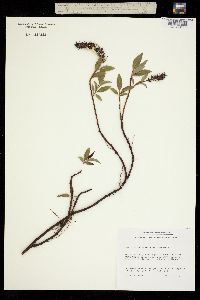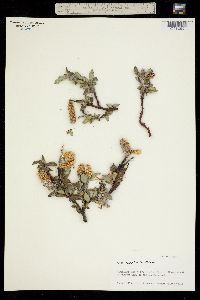Salix arctophila
|
|
|
|
Family: Salicaceae
Northern Willow
|
Plants 0.03-0.15 m, (dwarf), forming clones by layering. Stems prostrate, long-trailing; branches yellow-brown, red-brown, or green-brown, glabrous; branchlets yellow-green or yellow-brown to red-brown, (sometimes weakly glaucous), glabrous, (inner membranaceous bud-scale layer free, not separating from outer layer). Leaves: stipules rudimentary, absent, or foliaceous on early ones, foliaceous or rudimentary on late ones; petiole 3-7.8-15 mm; largest medial blade hypostomatous or hemiamphistomatous, elliptic, obovate, broadly elliptic, broadly obovate, subcircular, or oblanceolate, 15-31-60 × 6.5-16-35 mm, 1.2-3-4.3 times as long as wide, base cuneate, convex, or rounded, margins slightly revolute, inconspicuously crenulate or entire, apex usually acute or convex, sometimes rounded, abaxial surface glaucous, glabrous, adaxial slightly or highly glossy, glabrous; proximal blade margins entire or serrulate; juvenile blade glabrous. Catkins: staminate 19-54 × 7-16 mm, flowering branchlet 4-20 mm; pistillate densely to moderately densely flowered, slender to subglobose, 30-79(-130 in fruit) × 10-20 mm, flowering branchlet 8-57 mm; floral bract brown, black, or bicolor, 0.8-2.4 mm, apex rounded or acute, entire, abaxially densely hairy, hairs straight. Staminate flowers: abaxial nectary absent, adaxial nectary oblong, square, narrowly oblong, or ovate, 0.4-1 mm; filaments distinct or connate less than 1/2 their lengths, glabrous, or hairy on proximal 1/2; anthers ellipsoid or long-cylindrical, 0.5-0.7 mm. Pistillate flowers: abaxial nectary absent, adaxial nectary oblong or narrowly oblong, 0.5-0.9 mm, shorter than stipe; stipe 0.8-1.4 mm; ovary pyriform or obclavate, pubescent or short-silky, (refractive), hairs (white, grayish, or ferruginous), crinkled, often refractive, ribbonlike, beak gradually tapering to styles; ovules 8-16 per ovary; styles connate or distinct 1/2 their lengths, 0.6-1.4 mm; stigmas slenderly or broadly cylindrical, 0.24-0.47-0.72 mm. Capsules 5-9 mm. 2n = 76. Flowering late May-late Jul. Arctic-alpine, subarctic, hummocks in wet, mossy, grass or sedge meadows, margins of streams or ponds, among granite boulders, on alluvial plains, sometimes in snowbeds; 40-600 m; Greenland; Man., Nfld. and Labr., N.W.T., Nunavut, Ont., Que., Sask., Yukon; Alaska, Maine. Salix arctophila occurs in western Greenland. Hybrids: Salix arctophila forms natural hybrids with S. arctica, S. glauca var. cordifolia, and S. uva-ursi. Salix arctophila × S. glauca var. cordifolia: Plants with villous leaves and moderately densely hairy branchlets and branches suggest this hybrid. Putative hybrids are rare but have been seen from Kuujjuaq and Ivujivik, Quebec (G. W. Argus, unpubl.), and are reported to be common in West Greenland (T. W. Böcher 1952). Salix arctophila × S. uva-ursi is a rare hybrid. The plants often have ovaries with patches of hairs, some of which are ribbonlike, as in S. arctophila, but their habit is compact, as in S. uva-ursi, rather than long-trailing as in S. arctophila. Some specimens are infertile and are evidently hybrids, but there is little to confirm S. uva-ursi as the second parent. N. Polunin (1940b) also expressed some uncertainty about plants intermediate between S. arctophila and S. uva-ursi, and A. K. Skvortsov (1971) discounted this hybrid but noted that there were a few somewhat doubtful specimens.
Trailing shrub; vegetative parts all glabrous; twigs yellowish-brown, sometimes pruinose; buds 3-8 mm; petioles 5-12(-24) mm; lvs elliptic-obovate to obovate (the apical ones rarely obovate-oval and subcordate), 2-4(-5) נ1.5-3 cm, acute to apiculate, shallowly crenate- denticulate toward the tip, dark green and shining above, glaucous beneath, prominently and slenderly raised-reticulate on both sides; catkins after the lvs, 3-9 cm, rather lax, erect on leafy peduncles 1-4 cm; scales blackish, long-villous; stamens 2; staminate fls biglandular; fr slender, 6.5-8 mm, thinly silky; pedicels 0.5-1 mm; style 1-1.5 mm; 2n=76. Marshy, mossy, low places in the mts., or sometimes in drier areas; Mt. Katahdin, Me., n. to Greenl. and Mack. (S. groenlandica) Gleason, Henry A. & Cronquist, Arthur J. 1991. Manual of vascular plants of northeastern United States and adjacent Canada. lxxv + 910 pp. ©The New York Botanical Garden. All rights reserved. Used by permission. |


































































































